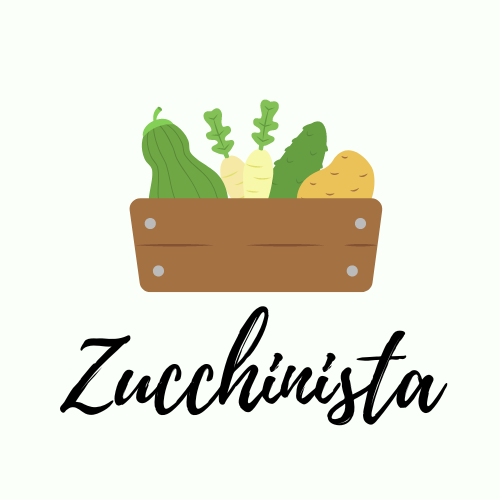This Iceberg Green Thai Curry is super simple to make and ready in no time! Just cut the vegetables into bite-sized pieces and let them get hot in the broth. This recipe can be freshly prepared quickly, even during a short lunch break! Just seven ingredients!
Iceberg lettuce can do so much more than you give it credit for. It’s capable of more than being the base of a bland side salad or the garnish on a burger.
I came up with the idea of preparing iceberg lettuce warm by accident. Due to its compact growth, iceberg lettuce has a long storage time for a salad and can certainly be stored in the refrigerator for 2 weeks without losing any of its freshness and crispness. Nevertheless, it happened that I found a head of iceberg lettuce in the back of my fridge that was already past its best. Not only did the outer leaves already have brown and dried up spots, the inner leaves were also a bit wilted and soft. To be honest, I had some qualms about eating it raw because I didn’t want to upset my stomach.
But I didn’t want to throw it away either. So I came up with the idea of cutting the leaves into strips and sweating them in a pan with some fat. What can I say, it was a revelation! The taste intensity of the iceberg lettuce had clearly increased through cooking. Instead of being a bit watery and styrofoam like when raw, it now tasted slightly sweet and nutty. It loses its crunchy consistency somewhat, but the mild, nutty, slightly green aroma, reminiscent of other green vegetables such as spinach or Swiss chards, intensifies.
In terms of consistency and taste, it was slightly reminiscent of braised savoy cabbage, even if it only took a fraction of the time to prepare. Yes, once when I served iceberg lettuce prepared this way to my colleagues, they didn’t even notice that it wasn’t collard greens!
I find a cooking method like stir-fry or shortly simmering works best for the iceberg lettuce. In any case, the cooking time should be as short as possible. That’s why I chose this quick, minimalist Thai curry, which uses just a few ingredients but lets them really stand out. Here the iceberg lettuce is only heated long enough for the core to still be crunchy and its bright green colour.
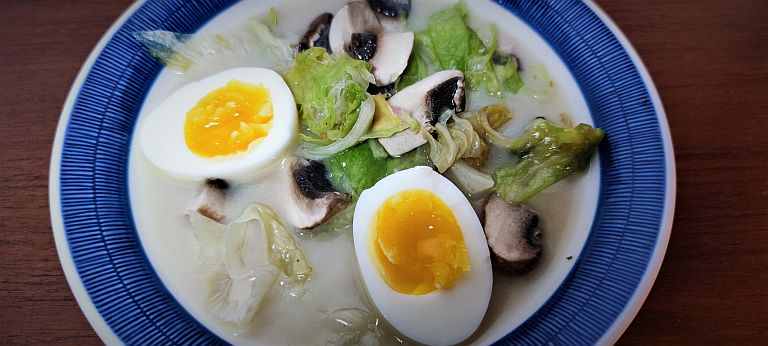
Why you’ll love this iceberg green Thai curry
Spicy and Aromatic – All the multi-layered and complex flavors of Thai cuisine, combining spicy, sweet, sour, hot and salty flavors, come into play here in the dish.
Iceberg lettuce also for people who are not salad lovers – instead of bland lettuce leaves in zesty dressing, the lightly cooked texture here allows the real aroma of iceberg lettuce to unfold.
Prepared in a maximum of 20 minutes – depending on how many portions you are preparing this curry for, the preparation time ranges from a few minutes to maybe 20 minutes. Most of the time is taken up by preparing and cutting the vegetables. The cooking time is extremely short because the vegetables in the broth are not cooked, but only have to be simmered below the boiling point.
Minimalistic and versatile – Only 7 ingredients! The types of vegetables can also be varied endlessly.
Made with staple ingredients – coconut milk, Thai curry paste and (grained) broth are part of the basic equipment of every kitchen today. The dish can be prepared spontaneously.
Can be made mild or hot – depending on your preference for spicy food, you can use more or less Thai curry paste, add chili flakes to the dish, or add more coconut milk to make it milder and creamier.
Work with all your favorite toppings – you can keep the dish minimalist as featured here, or spice it up with fresh cilantro, spring onions, roasted peanuts, or any other topping of your choice.
Naturally low carb and keto – this dish is naturally extremely low in carbs without sacrificing flavor.
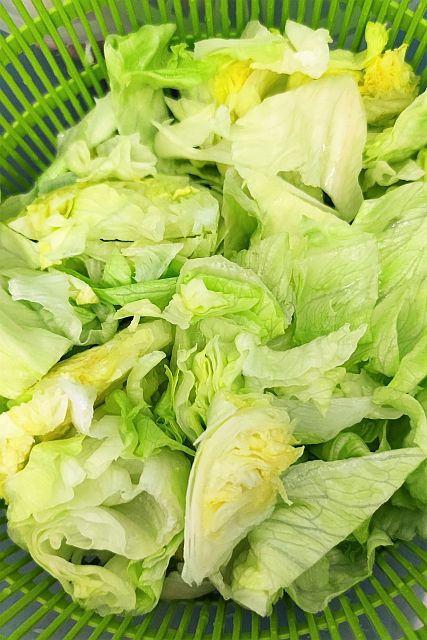
Benefits of Iceberg lettuce
Iceberg lettuce has a reputation for being rather nutrient-poor. But I think this view is exaggerated and see no reason to demonize him. Although it contains more water than other lettuce, it is also particularly low in calories. It brings a lot of dietary fiber and quite a few micronutrients:
- vitamin C (It contains more than other kinds of lettuce)
- beta-carotene (which is a precursor for vitamin A)
- folic acid,
- B-vitamins
- and potassium.
And above all: it is better to eat iceberg lettuce than no lettuce at all.
Thanks to its fresh, crisp and mild taste, it is so pleasant to eat that one easily consumes a large portion of it. In contrast to other types of lettuce such as frisee lettuce, radicchio or chicoree with their very distinct bitter notes, I like to eat iceberg lettuce almost every day.
Some short notes on Thai Curry
The green color of the green Thai curry paste comes from the fresh, dark green chillies. The green variety is slightly spicier than the other types of curry paste – red, yellow, massaman or panang – and has a stronger ethereal taste of lemongrass and kaffir lime zest.
Of course you can make the Thai curry paste from scratch yourself. Traditionally, the ingredients are ground in a stone mortar until they form a thick, homogeneous paste. The homemade paste can be made in advance and stored in the fridge, so that the preparation time is still short.
While I’m writing this right now, I feel like trying it myself. Stay tuned, I hope to be able to present homemade Thai curry pastes on the blog in the near future. But for this recipe I would like to limit this blog post to the store bought pastes.
But there are very good, aromatic and high-quality Thai curry pastes that you can buy in stores. This is especially true for brands that can be bought in Asian stores. Here you can be sure that you are getting authentic quality that is also really hot and spicy. On the other hand, I would advise against the curry pastes that you can buy in the supermarket. These are often very feeble and not very spicy in taste. One would think that it is adapted to the European taste, which is not used to spicy spices. Perhaps these pastes are also stretched with all sorts of fillers. In any case, you have to use a lot of it and still don’t get such a full-bodied and aromatic taste.
Ingredients in Green Thai Curry Paste:
- fresh Thai green chillies (Phrik Khi Nu)
- garlic
- shallots
- lemongrass
- galangal root
- roasted coriander seeds and coriander root
- Kaffir lime zest
- shrimp paste
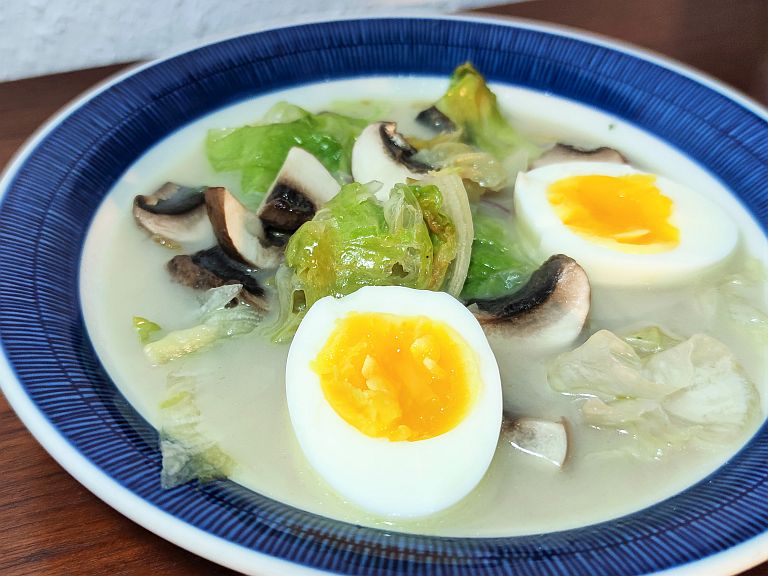
How to adapt this dish to your diet:
In addition to being low carb, gluten-free and nut-free, this dish also fits into a plant-based, paleo or Whole 30 ready diet if you make a few small adjustments.
Vegetarian and vegan:
Vegetarians and vegans should beware: usually a store-bought Thai curry paste is neither vegetarian nor vegan, but contains crab paste and fish sauce. However, adapting this dish to a vegetarian or vegan diet is no problem if you consider the following options:
- either you buy a certified vegan curry paste
- or you can make your own Thai curry paste without the non-vegan ingredients
- the fish sauce, with which a Thai curry is usually seasoned, can be replaced by soy sauce, coconut aminos, worchester sauce or tamari
- also the broth used to cook this dish can be a vegetable version such as vegetable broth
The option to serve the dish with eggs is by no means essential but also just a suggestion. For a vegan version you can simply omit the eggs or add silken asian tofu square or roasted cashews.
Paleo and Whole 30:
Also if you are following a Paleo diet or are in a Whole30 phase, watch out, the devil is in the detail. While the main ingredients are fresh and nutrient-dense and a great fit for these diets, the condiments often contain ingredients that are not Paleo-compatible. This could be soybean oil or soy sauce in the Thai curry paste, or sugar, preservatives and other additives.
Coconut milk also often contains additives such as the emulsifier polysorbate or thickeners, especially if it is the reduced-fat variety. But there are enough varieties of coconut milk that consist only of coconut extract and water. With the organic certified brands, you can also be sure that they are free of additives.
Soy-free
If you have a soy allergy or want to avoid soy for other reasons, you should also take a critical look at the ingredient lists of the condiments, i.e. Thai curry paste and fish sauce. Soy is often used here. Alternatives are ready-bought Thai curry paste without added soy, Coconut Aminos or fish sauce without additives, which consists only of anchovies, salt and water.
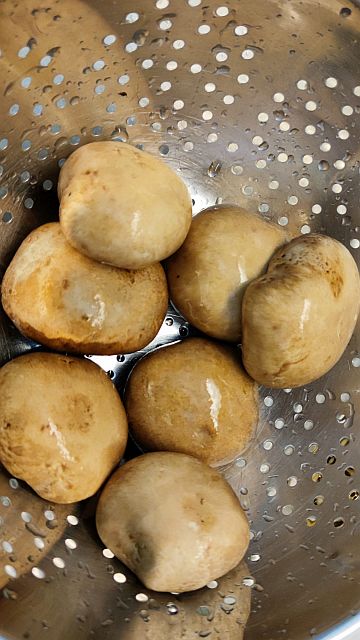
Best ways to enjoy
There are endless possibilities to vary this recipe.
To make it extra Thai, you can add the following to the finished curry:
- Thai basil
- chili flakes
- kaffir lime leaves
- fresh coriander
- sliced green chili pepper (e.g. cayenne peppers)
- small Thai eggplants
Instead of the mushrooms suggested in the recipe, you can also choose any other vegetable. Especially good would fit for example:
- red peppers cut into strips
- green beans (but they should be precooked)
- snow peas or young green peas
- broccoli florets
- cauliflower florets
Also the protein ingredient could be varied: instead of eggs you can use shrimp, crab, chicken meat or tofu.
If you use tofu, add the tofu cubes to the hot broth along with the iceberg lettuce at the end of the cooking time.
If using raw chicken or raw seefood, follow these steps:
Remove skins and tendons from chicken and cut into cubes. Heat the Thai curry broth to boiling point, add the chicken cubes and simmer until cooked through. De-head the shrimp or prawns, break them out of their shells and similarly cook them in the hot broth. Then add the rest of the vegetables and finally the iceberg lettuce.
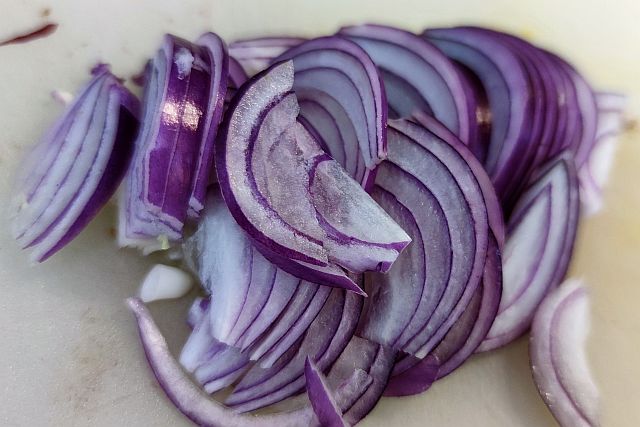
Serving as a main dish
In my opinion, this dish can be eaten very well as a low carb dish, i.e. without a starchy side dish. In this form, it works well as a lunch or as an appetizer to a multi-course dinner. But you can also serve it as a main dish with rice or cauliflower rice. If you choose rice, jasmine rice or fragrant rice is the type of rice that goes best with the Thai curry.
Best ways to store
To be honest, this dish needs to be made fresh and eaten right away. The iceberg lettuce is at its best when it’s just soaking in the hot broth. If it is exposed to the heat for too long, it will quickly become wilted, brown and unsightly. Sort of like the limp, spoiled-looking lettuce leaves you pick off a burger that’s been sitting in the warming counter too long. The only way I could imagine preparing the dish in advance would be to mix the liquids and the Thai curry paste together in advance and to pre-cook the mushrooms or other vegetables in it for a short time. The lettuce strips should then be added in just before serving.
I find a cooking method like stir-fry or short steaming works best for the iceberg lettuce. In any case, the cooking time should be as short as possible. That’s why I chose this quick, minimalist Thai curry, which uses just a few ingredients, but shows them off to their best advantage. Here, the iceberg lettuce is heated only long enough so that its crunchy texture is still perceptible in the core and it retains its bright light green color.
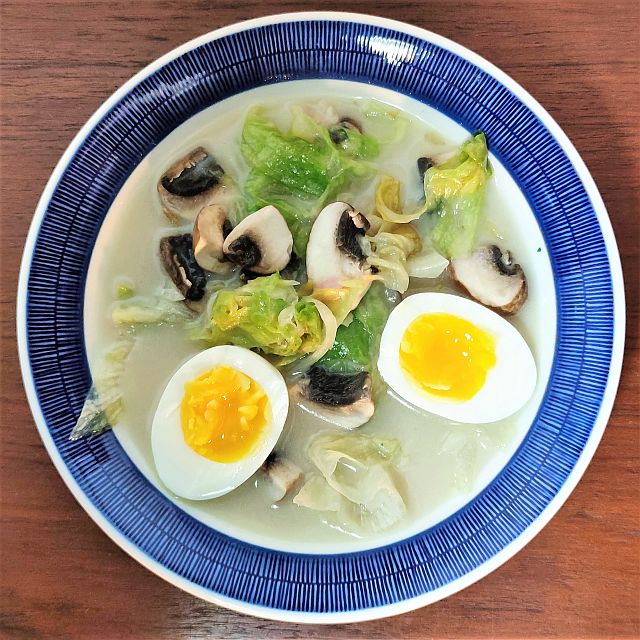
Iceberg Lettuce Green Thai Curry
Description
This quick and easy Thai curry dish is a great new way to prepare iceberg lettuce. It presents iceberg lettuce from a whole new perspective: as a versatile green leafy vegetable whose taste and texture when half-cooked go extremely well with Asian dishes.
Ingredients
Instructions
-
Bring water to boil in a small saucepan. Prick the blunt end of the eggs and let them gently slide into the boiling water. Let the eggs cook for 5 minutes until they have a waxy consistency.
-
Heat one-third of the coconut milk over high heat. Let it boil down until a thick consistency is reached. Now stir in the Thai curry paste and mix well. When a homogeneous mixture is formed, add the remaining coconut milk and vegetable broth and reduce the heat.
-
Season to taste with curry paste, salt, pepper and fish sauce or soy sauce. The broth should be hot but no longer boiling.
-
Remove the skin from the red onion. First cut it in halves and then in fine stripes. Add the onion strips to the pot with the broth and coconut milk.
-
Wash the brown mushrooms, cut them into slices or quarters depending on their size and add them to the hot coconut milk.
-
Meanwhile, prepare the iceberg lettuce. Pick off the outer leaves, cut out the stalk, and chop the leaves into rough strips. Wash them thoroughly and remove the excess water in a salad spinner.
-
Add the lettuce to the hot coconut milk a short time after the mushrooms. Leave the lettuce leaves in the broth just long enough to get hot. They should still have some bite and retain their leaf structure. Thus, they are served in a half-cooked state.
-
Rinse the eggs under cold running water and peel them. Let them slide into the hot broth as well.
-
Serve the dish quickly while the lettuce leaves are still fresh and green. Garnish with a handful of chopped, roasted cashews or peanuts and a generous helping of fresh, coarsely chopped cilantro.
